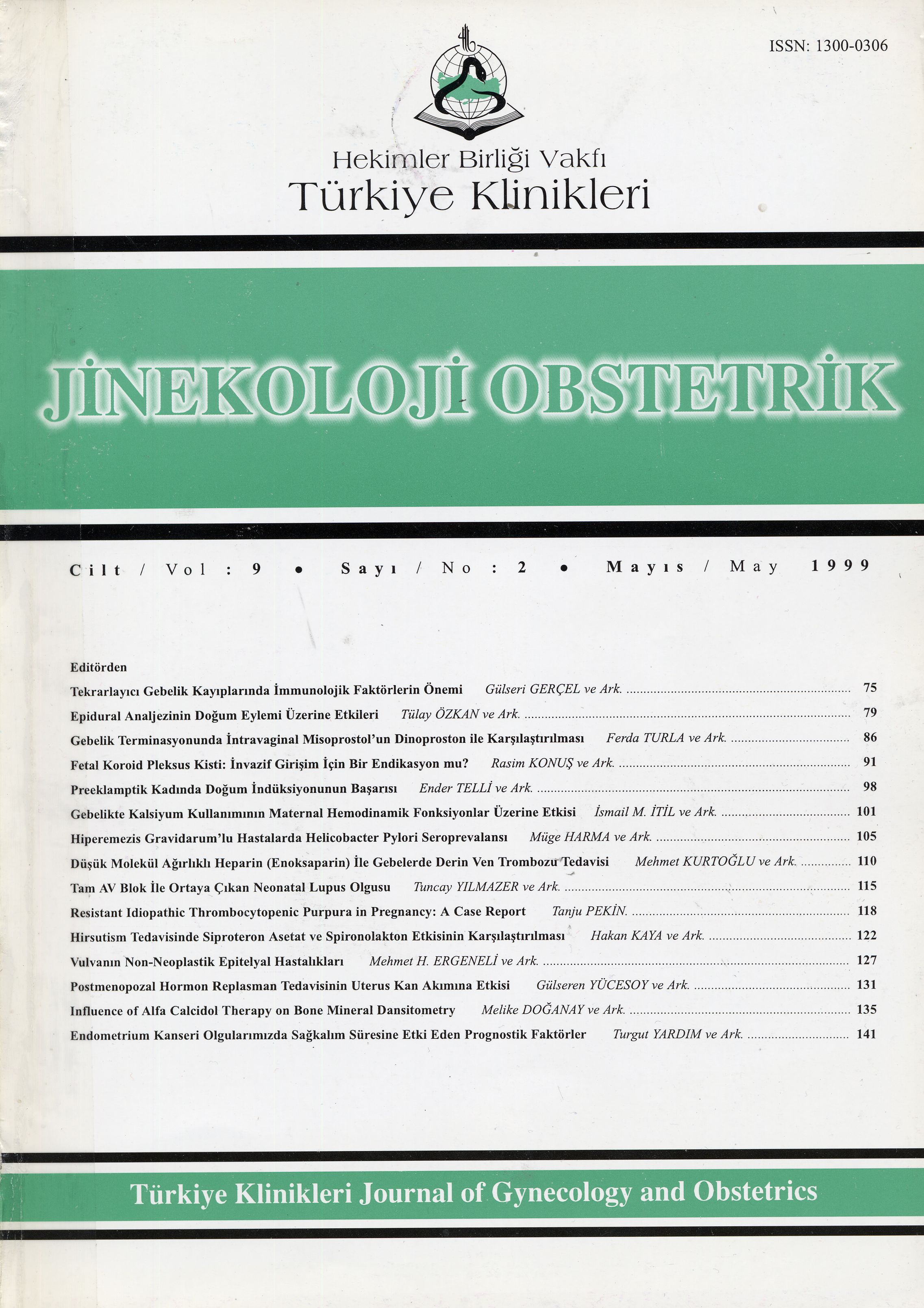Open Access
Peer Reviewed
ARTICLES
3149 Viewed1146 Downloaded
Influence Of Alfa Calcidol Therapy On Bone Mineral Dansitometry (BMD) In The Postmenopausal Period
Postmenopozal Peri̇odda A-calci̇dolun Kemi̇k Mi̇neral Dansi̇tometresi̇ Üzeri̇ne Etki̇si̇
Turkiye Klinikleri J Gynecol Obst. 1999;9(2):135-40
Article Language: TR
Copyright Ⓒ 2025 by Türkiye Klinikleri. This is an open access article under the CC BY-NC-ND license (http://creativecommons.org/licenses/by-nc-nd/4.0/)
ÖZET
Amaç: Bu prospektif çalışmanın amacı, postmenopozal dönemdeki hastalarda a-calcidolun kemik mineral dansitometresi üzerine etkisini belirlemektir. Çalışmanın Yapıldığı Yer: Dr.Zekai Tahir Burak Kadın Hastanesi, Menopoz Bölümü. Materyel ve Metod: 96 postmenopozal kadın (ortalama yaşları 50.2±1.3 yıl) menopoz başlangıcından 1 yıl sonra çalışmaya alındılar. a-calcidol tedavisinin endikasyonu postmenopozal osteoporozun önlenmesinde östrojen kullanımının kontrendike olduğu veya hastanın hormon replasmanını kabul etmemesi hali olarak belirlenmiştir. Günlük a-calcidol dozu (Alpha DR, TEVA) 0.5 mg olarak belirlenmiştir. Çalışma boyunca serum kalsiyum kreatinin ve idrar kalsiyum/kreatinin oranları belirlenmiştir. Lumbal vertebra (L2-L4) ve femur boynu kemik mineral dansiteleri DXA metodu ile (Lunar) 12 aylık periyodun başında ve sonunda ölçülmüştür. Sonuçlar: Tedavi süresince ortalama lumbal (L2-L4) ve femur başını içeren Z-skoru ölçümleri (-1.12±0.27) ile (-0.71±0.29) (p<0.05) arasında değişim göstermiştir. Tartışma: Bu sonuçlar a-calcidolun postmenopozal dönemde kemik mineral dansitesi üzerinde pozitif etkisi olduğunu göstermekte ve ayrıca hormon replasman tedavisinin kontrendike olduğu durumlarda postmenopozal osteoporozu engeller görülmektedir.
Amaç: Bu prospektif çalışmanın amacı, postmenopozal dönemdeki hastalarda a-calcidolun kemik mineral dansitometresi üzerine etkisini belirlemektir. Çalışmanın Yapıldığı Yer: Dr.Zekai Tahir Burak Kadın Hastanesi, Menopoz Bölümü. Materyel ve Metod: 96 postmenopozal kadın (ortalama yaşları 50.2±1.3 yıl) menopoz başlangıcından 1 yıl sonra çalışmaya alındılar. a-calcidol tedavisinin endikasyonu postmenopozal osteoporozun önlenmesinde östrojen kullanımının kontrendike olduğu veya hastanın hormon replasmanını kabul etmemesi hali olarak belirlenmiştir. Günlük a-calcidol dozu (Alpha DR, TEVA) 0.5 mg olarak belirlenmiştir. Çalışma boyunca serum kalsiyum kreatinin ve idrar kalsiyum/kreatinin oranları belirlenmiştir. Lumbal vertebra (L2-L4) ve femur boynu kemik mineral dansiteleri DXA metodu ile (Lunar) 12 aylık periyodun başında ve sonunda ölçülmüştür. Sonuçlar: Tedavi süresince ortalama lumbal (L2-L4) ve femur başını içeren Z-skoru ölçümleri (-1.12±0.27) ile (-0.71±0.29) (p<0.05) arasında değişim göstermiştir. Tartışma: Bu sonuçlar a-calcidolun postmenopozal dönemde kemik mineral dansitesi üzerinde pozitif etkisi olduğunu göstermekte ve ayrıca hormon replasman tedavisinin kontrendike olduğu durumlarda postmenopozal osteoporozu engeller görülmektedir.
ANAHTAR KELİMELER: Menopoz, KMD
ABSTRACT
Objective: Aim of this prospective study was to assess the influence of alfacalcidol therapy on BMD of postmenopausal patients. Design: 96 postmenopausal women (mean 50.2±1.3 years) within one year after menopause were enrolled in the investigation. Indication of alfacalcidol therapy was to prevent the development of postmenopausal osteoporosis in such cases when oestrogen administration was contraindicated or the patients refused the HRT. Material Methods: Daily dose of alfacalcidol treatment was 0.5 mcg. During the therapy serum calcium creatinine and urine calcium-creatinine ratio were determined. BMD was measured in lumbal spine (L2-L4) and femur neck with DXA method (LunarR) before and after 12 months alfacalcidol administration. Results: During the therapy mean Z-scores measured in lumbal spine and in femur neck changed from (-1.12±0.27) to (-0.71±0.29 ) p<0.05). Conclusion: This result indicates that alfacalcidol treatment has a positive effect on BMD in the postmenopausal period and it can prevent the development of postmenopausal osteoporosis if hormone replacement therapy is contraindicated.
Objective: Aim of this prospective study was to assess the influence of alfacalcidol therapy on BMD of postmenopausal patients. Design: 96 postmenopausal women (mean 50.2±1.3 years) within one year after menopause were enrolled in the investigation. Indication of alfacalcidol therapy was to prevent the development of postmenopausal osteoporosis in such cases when oestrogen administration was contraindicated or the patients refused the HRT. Material Methods: Daily dose of alfacalcidol treatment was 0.5 mcg. During the therapy serum calcium creatinine and urine calcium-creatinine ratio were determined. BMD was measured in lumbal spine (L2-L4) and femur neck with DXA method (LunarR) before and after 12 months alfacalcidol administration. Results: During the therapy mean Z-scores measured in lumbal spine and in femur neck changed from (-1.12±0.27) to (-0.71±0.29 ) p<0.05). Conclusion: This result indicates that alfacalcidol treatment has a positive effect on BMD in the postmenopausal period and it can prevent the development of postmenopausal osteoporosis if hormone replacement therapy is contraindicated.
MENU
POPULAR ARTICLES
MOST DOWNLOADED ARTICLES





This journal is licensed under a Creative Commons Attribution-NonCommercial-NoDerivatives 4.0 International License.










